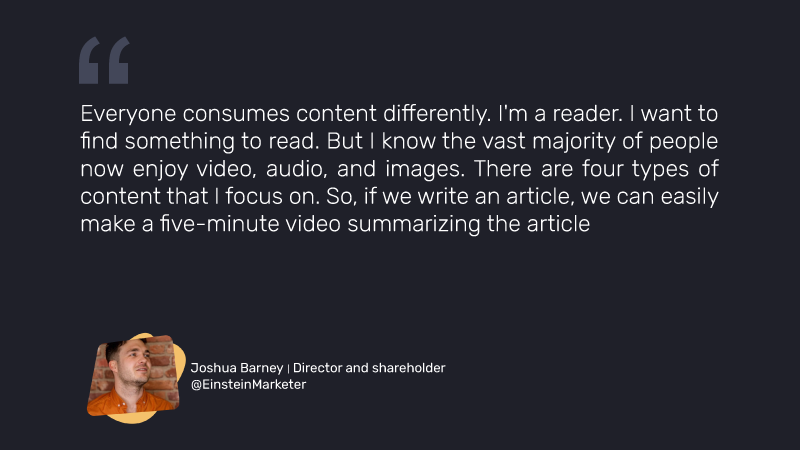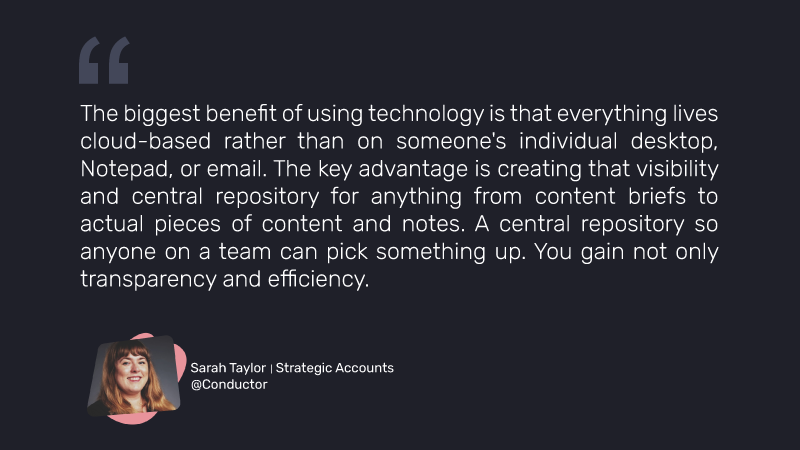It’s time to change your content marketing workflow
Enroll in the recently launched free academy.

Think, write, design. Copy, paste, send, receive, call, chat, approve, feedback, edit, call, chat, copy, paste, click-click.
Only the first three of the above activities — think, write, design – belong on a content marketer’s daily to-do list. This is what we should be spending our time on. Everything else takes up our workdays, evenings, and sometimes weekends. Why does that happen? First, we’ll convince you that your current workflow isn’t the way it has to be, and it definitely doesn’t come with the territory.
When asked, “What does your current workflow look like?”, content marketers we talked to had similar replies. “We brainstorm in a meeting, create a spreadsheet, send briefs to the designer in an email, get the assets in a folder, put together the work in a presentation, send it to internal stakeholders through email and chats, get feedback within the threads, implement the feedback in spreadsheets, copy-paste the content in the final environment, and publish.”
It’s not working
We can make do with this workflow, but it’s extremely hard work. We’re always rushing, but 60% of our projects still get delayed, our recent research discovered. We’re always innovating, but we found that 70% of brands and agencies still communicate through emails and showcase work in generic documents. We lose information, miscommunicate, and publish work that falls short. All these flaws in the way we work add up to creative professionals sorting emails and formatting spreadsheets rather than strategizing on new opportunities. These are not theoretical conclusions but the result of thorough research that revealed only 7% of marketers are truly happy with the way their team works.
Better workflows
From brainstorming strategic approaches to hitting that publish button, we need clear guidelines. The hows, the whos, and the whats need to be decided, mapped, and followed to unlock serious productivity. We have to leverage new opportunities to stay ahead. Do we have the bandwidth to take them on? Right now, we don’t. With new processes, we will.
Learn how
Raising standards in content collaboration and creative workflows begins with awareness and the deployment of technological resources that can help every content marketer out there produce better work. This is the founding premise for Planable’s Upgrade Your Content Marketing OS Academy. Planable has been around for over two years and has helped 5,000+ teams take their workflow to the next level. Planable’s collaboration software helps build seamless workflows, increases productivity and shifts the content marketers’ focus to what matters. By making it easy for teams to create, approve, schedule, and publish their content, Planable helps content teams take the first step toward real change.
In looking to raise global standards in content marketing, Planable decided to share its knowledge by offering free video courses on content marketing workflows. Key industry experts contribute advice to help teams upgrade the way they work. The free courses consists of six chapters, all video. Xenia, Planable’s CEO, and the Academy lead, is joined by 20 rock star guests who are on the frontlines of content creation and workflow management. Marketers will discover insights from marketing experts such as Mitch Joel, Alex Khan, Josh Fechter, Oliver Yonchev and Emma Lyskava from Social Chain; Somi Arian and Tim Soulo from Ahrefs, and many more.
Five things you’ll learn when you enroll in the Academy:
1. Great content wasn’t built in a day.
Great content can only be achieved with careful planning and research. The first part of the course dives deep into proper planning. Marketers will learn how to define their content goals and assign their resources. Understanding their audience takes time, but it is an essential part of the process of building relevant, engaging content.

The more you know about what you want to create and who will consume your content, the better. However, don’t overlook collecting information for each piece of content. Courtney Cormier, Content Marketing Manager at CPAP.com, encourages marketers to first consume content before creating content.

2. The right approval process will not slow you down; it will make you stronger.
“It’s really about understanding the constant communication loop between the client and the customer,” states Alex Khan, CEO of Attractive Media.
The way marketers showcase work to their stakeholders is essential to the process. Anyone who reviews and approves content should visualize the work as it will look like live. Such details contribute to a stable line of communication, which will undeniably impact the relevancy of the feedback.
Another key point addressed in the course is the tendency to blame this stage for delays. It doesn’t have to. The right approval process will ensure brand consistency, help the team align, act as a safety mechanism and unite everybody around the content.
3. It takes more than two to tango in a publishing flow.
Once marketing teams get approval, it’s time to publish the content. If publishing processes aren’t defined in time and there’s no coordination, the project usually gets delayed — resulting in chaos.
When we’re ready to hit the publish button, last minute details come up. How many of these sound familiar? “We didn’t write the copy for social.” “We don’t have the image for the featured post.” “Alt texts.” “Meta descriptions.”
Teams can eliminate these last-minute roadblocks by keeping the following questions in mind:
- What is needed? For example, videos need subtitles, articles need website uploading, imagery, maybe UTMs. Meta descriptions, author information, headshots, platform access, etc.
- Who is involved? Do you have a publisher? Does the content creator also publish the piece? Does the SEO team give input here?
- How do you align all the people? To make everybody involved and aware of their tasks, create a system that will work for your content every time.
4. Spread the word and clicks will follow.
“Brands are looking for unique ways to reach unique audiences,” says Academy guest Mitch Joel, founder of Six Pixels Group.
Many marketing teams consider hitting that publish button the finish line. But that’s only one lap of the race. After publishing, we have to spread the word. Our audience’s feeds get noisy and standing out becomes more difficult.
To distribute your content, you need more than a mass email asking people to share. Focus on creative assets, proper repurposing calendars and clear distribution channels. These efforts to have everything in place shouldn’t start after the content is live. They must be part of the initial plan to accurately estimate your content’s potential.
Marketers should be aware of how many forms their content can take. The insights you produce will fit one initial format: a video, blog post, or an infographic. Regardless of the way it’s first illustrated, it can then be transformed into alternative pieces of content to be distributed.

5. Tool up your team to get the best results.
Technology serves as the foundation for anything you want to build, and it should be at the heart of your team’s efforts. The Academy drills down on exactly how technology can move things forward and achieve efficiency and alignment. From automation fighting burnout, to built-in visibility preventing a PR crisis, the right tools should be the glue that holds everything together.

If you’re ready to dive deep into every step of the modern content workflow, check out how Planable Academy can help your team. Enroll for free.
Related stories